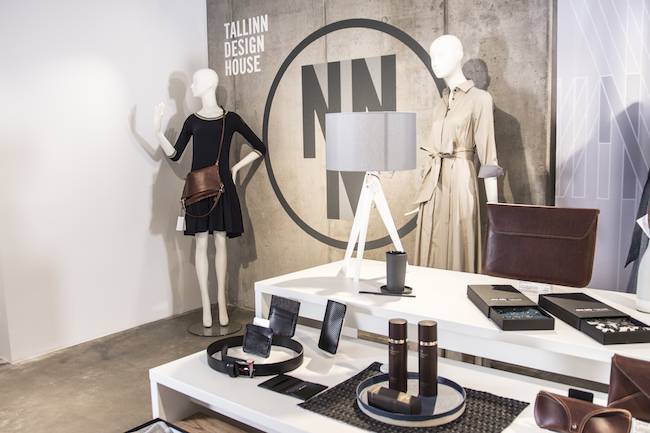
Tallinn Design House – a must-see for fans of Estonian design
29.08.2017
Tallinn Design House (TDH) is a must-see for fans of Estonian design. Located in Tallinn’s Rotermann Quarter – a neighborhood that relatively recently has regenerated itself from dereliction and is now one of the city’s most prestigious places for shopping, entertainment, and living – TDH is a design shop and multifunctional art space for presentations, events, and meet-ups.
This local alliance was founded through cooperation between the Tallinn Creative Incubator and Estonian designers who were in need of a marketing and sales platform. An intrinsic principle of TDH’s operations is for each maker to have a well-thought-out presentation of their respective brand. Anu Lõhmus, CEO of Tallinn Creative Incubator and the main person behind the TDH project, explains: “Most of our designers are not represented by other distributors as they have high demands how their products should be presented to avoid any damage to their brand recognition. As there are many different brands under the one roof of Tallinn Design House, the designers have to make sure that their products have the appropriate brand- and design-appeal to blend in, which is an absolute necessity when the goal is to enter foreign markets.” In an effort to learn more about the enterprise, we asked Lõhmus the following questions:
How did you come up with the idea for Tallinn Design House?
The idea for Tallinn Design House was born when I was visited by my friends living in Helsinki. They were wondering if there was a store or showroom in Tallinn where they could buy local design apparel and accessories. Unfortunately, there was no such venue in Tallinn where high-end design would have been available at a single location. It was located in separate stores and studios all over town – you would have had to make an appointment with each designer and visit each store separately.
How would you describe TDH’s contribution to the Estonian design scene as a whole?
Estonia has many good designers offering high-quality products, but they lack experience in cross-marketing and international sales. They mostly utilize B2C business models, which are usually inadequate for achieving a leading market position and the expansion of product families. TDH is specifically designed as a cross-marketing and sales platform that provides designers with the necessary toolbox for presenting and selling their brand in a multi-brand environment.
Could you list some highlights from this selection?
Representatives of exclusive fashion design would be: Amanjeda by Katrin Kuldma, Pohjanheimo, Piret Ilves, Kristiina Viirpalu, Jana Varkki, and Ellen Richard.
Interior lighting and furniture design: 4ROOM, Tõnis Vellamaa, Borg, Jaanus Orgusaar, Bolefloor, Okkaplaat, and Toivo Raidmets.
From jewelry design: Miikael Danieljants, Annika Kedelauk, and Birgit Skolimowski.
We also carry Liisu Arro ceramics.
I would also like to point out our bio-organic cosmetics lines, especially D’Difference by Dr. Ruth Oltjer, who, years ago, in cooperation with doctors, biochemists and scientists, started to search for solutions for the treatment of burns and bedsores. The results were amazingly effective and have now been applied to an exclusive skincare and cosmetics line.
Are there any special activities planned besides the shop’s daily sales operations (e.g., exhibitions, cultural events, etc.)?
Tallinn Design House can boast with having high-tech presentation capabilities for a variety of sales, presentation, and events opportunities. The environment can be accommodated for product and fashion shows, workshops, training seminars, and other informal meet-ups. During our first month, several fashion and marketing events, product launches, and partner meetings have been held. Our partners include high-profile international culture festivals like the Black Nights Film Festival and the Jazzkaar Music Festival, with whom we cooperate on several event programs. In addition, we work closely with several fashion and design projects like Disainiöö, by organizing exhibitions and seminars. Our small conference room is ideally equipped for small organizations that want to break from everyday routine and spend an inspiring afternoon in a creative environment.
Who worked on the shop’s interior design concept, and what was their idea behind it?
Our facilities were designed by interior architect Igor Volkov, fashion designer Katrin Kuldma, and light designer Krista Kunnus. The goal was to achieve a minimalistic and refined background that would work for a variety of design products.
How did you deal with the historic context of Rotermann Quarter and the building in which Tallinn Design House is located?
Rotermann Quarter is fast becoming a trendy center for the entire city, and due to its rich cultural history, it is attracting more and more visitors. This is where Andrei Tarkovsky’s famous movie “Stalker” was shot, with Tallinn Design House being situated right next to the so-called “Stalker Passage”. Our interior design also incorporates old stone walls and door arches. By melding the old with the new, we have created a comfortable yet refined and minimalistic environment.
If Tallinn Design House was a journey, how would you describe it?
Tallinn Design House is a pleasant, ever-evolving journey. It acts as a bridge between creativity and innovation, and between minimalistic aesthetics and rich taste.
Article appeared in www.artterritory.com.